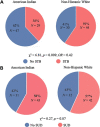Neural processes of inhibitory control in American Indian peoples are associated with reduced mental health problems
- PMID: 35801628
- PMCID: PMC9949499
- DOI: 10.1093/scan/nsac045
Neural processes of inhibitory control in American Indian peoples are associated with reduced mental health problems
Abstract
American Indians (AI) experience disproportionately high prevalence of suicide and substance use disorders (SUD). However, accounting for risk burden (e.g. historical trauma and discrimination), the likelihood of mental health disorders or SUD is similar or decreased compared with the broader population. Such findings have spurred psychological research examining the protective factors, but no studies have investigated its potential neural mechanisms. Inhibitory control is one of the potential neurobehavioral construct with demonstrated protective effects, but has not been examined in neuroimaging studies with AI populations specifically. We examined the incidence of suicidal thoughts and behaviors (STB) and SUD among AI (n = 76) and propensity matched (sex, age, income, IQ proxy and trauma exposure) non-Hispanic White (NHW) participants (n = 76). Among the AI sample, functional magnetic resonance imaging (fMRI) data recorded during the stop-signal task (SST) was examined in relation to STB and SUDs. AIs relative to NHW subjects displayed lower incidence of STB. AIs with no reported STBs showed greater activity in executive control regions during the SST compared with AI who endorsed STB. AI without SUD demonstrated lower activity relative to those individual reporting SUD. Results are consistent with a growing body of literature demonstrating the high level of risk burden driving disparate prevalence of mental health concerns in AI. Furthermore, differential activation during inhibitory control processing in AI individuals without STB may represent a neural mechanism of protective effects against mental health problems in AI. Future research is needed to elucidate sociocultural factors contributing protection against mental health outcomes in AIs and further delineate neural mechanisms with respect to specific concerns (e.g. SUD vs STB).
Keywords: American Indians; fMRI; inhibitory control; protective factors; substance use; suicide risk.
© The Author(s) 2023. Published by Oxford University Press.
Figures
References
-
- American Psychiatric Association . (2000). Diagnostic and Statistical Manual of Mental Disorders, 4th edn, Washington, DC: Text Revision, American Psychiatric Association.
-
- American Psychiatric Association . (2013). Diagnostic and Statistical Manual of Mental Disorders, 5th edn, Washington, DC: American Psychiatric Association.
Publication types
MeSH terms
Grants and funding
LinkOut - more resources
Full Text Sources
Medical


